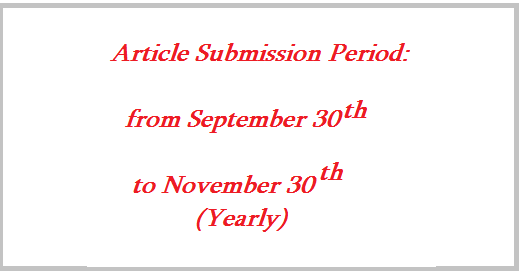The Structural and Lexical-Semantic Groups of the Terms Denoting Colours in the Georgian Symbolists’ Works
DOI: 10.55804/jtsuSPEKALI-18-17
The scientific study of the theory of colours has a long history. It is difficult to understand how colours were perceived in the ancient times. In this regard, the old literary sources provide us with the scanty information.
The ancient authors were the first, who discussed a colour and a shape. Afterwards, Leonardo da Vinci became interested in this issue. Goethe distinguished the "cold" and "warm" colours.
In the 19th-20th centuries, a special attention was paid to the study of the problematics of colours. It is noteworthy that the discussion of the universal categories of colours is based on the issue of defining the terms (of simple morphological structure) related to the basic colours. Berlin and Kay (1969) dedicated their special work to the study of this issue. According to the authors, the type of the system of terms related to colours is determined by the terms denoting the basic colours that are equally understandable to everyone.
According to Eter Soselia, when we get acquainted with the terms denoting different colours, we intuitively feel that some of these terms are basic. For example, Georgian white, black, red, yellow... , but raspberry-coloured, crimson, purple, dark green, reddish and others cannot be considered as basic terms. Berlin and Key's theory is based on such main terms and the authors call them basic colour terms [Soselia, 2009:10].
Some of the researchers of the semantics of the colour vocabulary (Frumkina, Vezhbitska...) do not theoretically recognize the category of colour and therefore, do not share the definition given in Berlin and Kay's work. However, the necessity of this category is important and the researchers refer to it with different names in their works.
Based on the methodology of our research, we decided to devote the particular part of the paper to the semiotic analysis of a symbol as an aesthetic sign. The development of the modern semiotics introduces the problematic novelty in the part of semantics that investigates the process of forming contextual meanings of words. It is urgent for the modern linguistics. The purpose of a symbol is to represent a cultural paradigm in its entirety.
It should be noted that from a symbolic point of view one can single out:
a) The colour symbol of the first type, i.e. the colour itself (the basic colours: white, black, grey, red, yellow, green and blue);
b) The colour symbol of the second type, which contains two or more colours, whose value is not a sum of meanings of individual colours;
c) The colour symbol of the third type as concrete physical objects, for example, the precious stones: emerald, ruby, gagate, amber, blue spar, hyacinth... the precious metals: gold, silver.
The symbolic meaning of colours is different in various cultures. For example, in the Western society, black is associated with death, while in the Eastern countries, white is considered as a symbol of death.
Any colour evokes positive or negative emotions and its meaning is founded on symbolism based on direct associations. It can be said that each symbol should be assigned an associative value, which indicates to its semantic field. For example, one of the meanings of red is related to the physiological reaction - the state caused by anger or shame. Accordingly, the expression "blush with shame" has its counterpart in different languages. The same can be said about the following expressions: "black market", "black list", "black day", "black plague", "black magic", "black Friday", "black box", "white knight", "white flag", "Grey Cardinal", "yellow card", "yellow press", "yellow light", "looking through rose glasses", "Red Friday", "red light", "red alert", "green cover", "green light" and others.
As it is known, the group of basic colours includes: white, black, grey, red, yellow, green and blue. The opposition white and black is related to the concepts of light (day) and darkness (night). Grey is perceived as a dull colour. Red, which is included in the chromatic group, contains the concept of blood (war, fire) in its reference. Yellow is associated with the sun, green - with nature, vegetation, blue - with the sky or water.
Basic colours have a positive or a negative charge. Let us discuss each of them:
White colour expresses: beauty, delight, light ("white as the moon"); blessing ("May the white Archangel support you!"), curse ("Do not wear white!"), fear ("being white from fear"), heartache, thinking ("I woke up white!"), sickness ("all white"), human hair (white-bearded), colour of skin (white-faced), kind-hearted person ("white-hearted”, pure person).
White can also be found in the following words and expressions: in the composites: with a white cloak, white-stoned, white-mixed... in the verbs and nouns: whitened, was whitened, bleaching, bleached, made white, is being whitened... in the syntagmata: in the names of animals - white-bellied fish , white horse, white dog, white fox, white bear, white night...
In the poetry, each colour expresses a corresponding event or quality (sadness, illness, foxiness, joy, beauty, heartache, threat, request, blessing, anger, fear...).
In the Georgian symbolic poetry, white is often associated with cold, winter, loneliness, sadness and death: "They buried a woman with white flowers. / The dead are waiting for open irises" ("From the last poems", Carmel); "...and when the end of the country comes upon us, / we will laugh dressed in white" ("We - "Blue horns", Mitsishvili).
White is characterized by the following qualities: cold, brilliant, bright... it is associated with angels, the moon, snow and ice. On the one hand, whiteness of snow is a symbol of purity. On the other hand, it is a symbol of coldness.
White is an epithet of the words: George, angel, dove, snow, glacier, cloud, winter, Aragvi, mountains, flame...
"The white glacier can be seen in the distance" ("Autumn day in Okrokana", Titsian Tabidze); "White doves / in white clouds, / white George, / the horse with the angel, / eschatology" ("The horse with the angel", Titsian Tabidze);
Events with the colour of light and darkness have positive and negative meanings. Pure, bright, light is connected with hope: "You will enter, you will see the hall... plain, bright, noble" ("Theatre", Paolo Iashvili).
Pallid, wan, pale, delute, to pale, colourless, lifeless, doleful and unhappy: "The queen's face is pale, like a swan in the fog" ("The King's Wedding", Paolo Iashvili).
Black color expresses: sadness, mourning (dressed in black); death (,,...black death also has its spring" (Titsian Tabidze); threat ("Won’t I just give it him!” i.e. put him in black/bad conditions); misfortune (having black days, having black destiny); scolding (setting a black day); humiliation, insult, ugliness ("black as a crow"); slyness ("black fox"); distress, plague ("black plague"); the darkness of time (Dark Times); the colour of a person's face, hair, eyes (black-faced, black-haired, black-eyed).
The analysis of the chromatic colours (white-black) showed that black carries the semantics of unconscious and the future tense. Comp. ღამე/ghame (night), აღმა გაღმა/aghma, gaghma (up and beyond)... თვალის ამოღამება/tvalis amoghameba (getting bags/shadows under the eyes), ღამურა/ghamura (bat)... The ღმ/ღამ (ghm/gham) root should be associated with invisibility. It can also be associated with obscurity of future.
To reveal the expression of a negative emotion, words containing a neutral member of colour are confirmed. For example: გულშავი/gulshavi (black-hearted), შავბნელი/shavbneli (dark), გულშავობა/gulshavoba (black-heartedness), სიშავე/sishave (blackness), etc.
In literature (not only in Georgian) black is often associated with emptiness and sadness. "It's a black night, the sky is mourning" ("Autumn night"); ,,.. the black affliction does not leave me" ("Melody"); "the black death is around you" ("Tremble, Valtasar!", Titsian Tabidze)
Events with the colour of darkness have a negative meaning. Blackness, shadow, twilight, dusky, dark, darkness are associated with death and sadness, while the night takes the form of mystery: "The sky closed its eyes, it got dark" ("Rain in the city", Apkhaidze); "The world sleeps, clouded with the fog, / the night is opaque and dark" ("To the Muse", Titsian Tabidze).
The words included in the group of grey express: ugliness ("He/she is looking with the grey eyes, like a cat"); paling ("He/she turned grey"); anger ("He/she turned the colour of earth"); illness ("He/she has the colour of a dying person"); colour of human eyes and hair (grey eyes, grey hair); names of birds and animals (black-grey bird, grey horse, grey bear).
Grey is rarely found in the poetry of "Tsisperkantselebi" and does not have a positive connotation: "Those, who utter poems with tears and grey anger" ("The Third Afterglow", Gaprindashvili); "He went to the garden with laurels, / made it turn grey" ("Autumn Day in Poti", Paolo Iashvili).
Red expresses: ugliness ("red eyes"; "red man"); threat (We will paint you red!); illness (Anthony’s fire (in Georgian წითელი ქარი/tsiteli kari - (red wind)); approach of death ("The water turned red"); mourning (painted red and black); shyness (becoming red from shame); feeling of shame (red face); anger (red like pepper); colour of soil ("red soil"); colour of human face and hair (red-faced person; red-cheeked, red-haired).
According to the Georgian symbolists, red is the colour of evil. It is related to blood, war, revolution, death: "The red horror is barking in your palace" ("Verharn", Paolo Iashvili)); "The red death is sent to us" ("The Red Bull", Piolo Iashvili).
The semantic field of yellow is represented as follows: expressing envy (yellow from envy); sick colour (yellowish (sick) face); denoting the colour of human eyes, facial skin and hair (honey-eyed, golden (bright) face, golden-haired).
Yellow mostly has a negative connotation in the poetry of "Tsisperkantselebi": "You are yellow, like a lunatic asylum" ("Autumn", Gaprindashvili); "Fear and yellowing!" ("Sanbenito", Carmel).
Green expresses: cursing ("green face"); beauty of nature ("The whole country was clothed in green"); illness ("turned dark green"); colour of a human eye (green-eyed).
In the poetry of "Tsisperkantselebi", green is associated with flowering, nature, spring: "Spring was green" ("The death of the tree", Nadiradze); "I'm already in the mountains... the forest is green all around" ("In the mountains", Mitsishvili).
Blue expresses: threat ("His/her eyes and face turned blue"); illness (having blued eyes); paling (turned blue); words denoting the sky (the blue dome, the blue space of the sky); water (blue waves of the Mtkvari); colour of a human eye (blue eyes).
In the poetry of "Tsisperkantselebi", blue is a cold, sad colour: "I was alone!.. There was the blue darkness around me" ("Overture”, Paolo Iashvili)
In conclusion, it can be said that the main colours have both positive and negative meanings, although it should be noted that grey has only a negative meaning (hopelessness, obedience, indifference, affliction, moan, boredom, uncertainty, timidity).
Color (ფერი/peri – in Georgian) is also found as a constituent part of other composites: ფერდაკარგული/perdakarguli (turned pale), ფერწასული/pertsasuli (turned pale), ფერმიხდილი/permikhdili (ashen), ფერგამქრალი/pergamkrali (faded), ფერმკრთალი/permktali (pale), ფერისცვალება/peristsvaleba (transformation), მრავალფეროვანი/mravalperovani (variegated), ფერად-ფერადი/perad-peradi (many-coloured)... არაფერი/araperi (nothing), ყველაფერი/kvelaperi (everything), მრავალფერი/mravalperi (multi-coloured)...
Sometimes colour is not mentioned in the poems of "Tsisperkantselebi", but contexts indicate that colour is implied. In this regard, the names that characterize the phenomena of light and colour are singled out as a separate group. There are the categories like light and dark, funny and sad. The words denoting the characteristics of colour are: pale, dark, washed out, faded, bright, twinkling, brightly shining, shimmering, shiny, dull, sharp, pallid, cloudy, pressed, dark, matte, decrescent, cheerful, bright, sated, glossy, brilliant white, dazzling (white), light, glimmering, colourful, of all colours, bright green...
One of the sources of enrichment of the vocabulary denoting colours is artistic creativity written with the literary language. In case of the Georgian symbolists, the names of colours are presented in the form of a stem, a conjugation, plural formed with nar and eb, a preverb or a postposition. The names of colours may be expressed with the function of an adverb of manner and a diminutive degree (mo- -o, -u -es, si-e).
"That black day of the ancestors..." ("Morning", Mitsishvili); "Someone black on the road to Shemakhi..." ("Haji Murat's cut head", Mitsishvili); "...and the bank of the Mtkvari lies in green" ("Now, when", Apkhaidze); "...and the black thrushes spoiled the gardens" ("The Journey to the motherland", Leonidze); "I remember you sitting in black with me and our spring..." ("I remember in black", Shaniashvili); "You wake up white: evil delusions attack you" ("To the French poet", Grigol Robakidze); "Let's sit quietly into the white boat" ("Baldakhini", Nadiradze).
Verbs and infinitives are made from adjectives denoting colours: "Presna and February are turning white" ("Vladimir Mayakovsky's mother and sisters", Titsian Tabidze); "This hotel was blue with your breath" ("Smell of your body", Nadiradze).
There are the cases, when the word denoting color is the first or the second part of the composite: შავბედი/shavbedi (bad luck), შავნაბდიანი/shavnabdiani (wearing a black felt cloak), შავთმაჩაშლილი/shavtmachamoshlili (with an undone black hair), შავგრუზა/shavgruza (black and curly), შავრაშიანი/shavrashiani (having a black horse), შავკაბიანი/shavkabiani (wearing a black dress), შავმოგარსული/shavmogarsuli (having a black casing), შავფრთიანი/shavprtiani (black-winged), შავფერი/shavperi (black), შავპირი/shavpiri (black-faced), შავბნელი/shavbneli (dark), შავთვალა/shavtvala (black-eyed), თეთრქაფა/tetrkapa (having a white foam), წითელგულა/tsitelgula (red-eyed), წითელდროშოვანი/tsiteldroshovani (red-flagged), ყვითელმზერიანი/kvitelmzeriani (having a yellow beholding), ყვითელფერობს/kvitelperobs, ლურჯთვალა/lurjtvala (blue-eyed); თმათეთრი/tmatetri (white-haired), ბედშავი/bedshavi (unlucky), პირშავი/pirshavi (black-faced), ფერშავი/pershavi (black), წვერწითელა/tsvertsitela (red-bearded), თმათეთრი/tmatetri (white-haired), ფერწითელობა/pertsiteloba (reddishness).
"Tsisperkantselebi" use the colour words with complex stems derived from the component "colour"(ფერი/peri), which is dominant in the literary Georgian language, for instance: აგასფერი/agasperi, ალისფერი/alisperi (scarlet), ატმისფერი/atmisperi (peach-coloured), გოგირდისფერი/gogirdisperi (sulphur-coloured), ვარდისფერი/vardisperi (pink), ვერცხლისფერი/vertskhlisperi (silver), ზღვისფერი/zghvisperi (sea-blue), თაფლისფერი/taplisperi (honey-coloured), თოვლისფერი/tovlisperi (snow-coloured), იისფერი/iisperi (violet), კომშისფერი/komshisperi (quince-coloured), კუპრისფერი/kuprisperi (black), ლალისფერი/lalisperi (ruby), ლაჟვარდისფერი/lazhvardisperi (azure), მარგალიტისფერი/margalitisperi (pearl-colored), მარწყვისფერი/martskvisperi (strawberry-colored), მარჯნისფერი/marjnisperi (coral), მზისფერი/mzisperi (colour of the sun), მთვარისფერი/mtvarisperi (colour of the moon), მიხაკისფერი/mikhakisperi (dark brown), მტრედისფერი/mtredisperi (color of a dove), ნაცრისფერი/natsrisperi (grey), ოქროსფერი/okrosperi (golden), ჟანგისფერი/zhangisperi (rubiginous), სანთლისფერი/santlisperi (colour of a candle), სისხლისფერი/siskhlisperi (purple), ფირუზისფერი/piruzisperi (turquoise), ქარვისფერი/karvisperi (amber), ღამისფერი/ghamisperi (colour of night), შვინდისფერი/shvindisperi (cornelian-red), შინდისფერი/shindisperi (wine-red), ცეცხლისფერი/tsetskhlisperi (scarlet, fire-coloured), ცრემლისფერი/tsremlisperi (colour of a tear), წვიმისფერი/tsvimisperi (color of rain), ხავერდისფერი/khaverdisperi (velvet-colored), ხავსისფერი/khavsisperi (mossy), ხორბლისფერი/khorblisperi (wheaten), ხოხბისფერი/khokhbisperi (colour of a pheasant).
Accordingly, colour in literature is stimulated by a symbolic thought. It is difficult to make a sharp separation of colours in the artistic system of "Tsisperkantselebi", although white, black and blue and the synonymous units included in this group are preferred.
Every new object, form or event is the reason for the emergence of new words. This fact leads to the occurrence of new lexical units/neologisms in the language, for example, ლომფერი/lomperi belongs to Galaktion Tabidze.
In the Georgian symbolists’ works, there are words of colours composed of pronouns or numerals, for instance: "The sky with the seven-coloured rainbow" ("Happy journey", Iashvili); "That sky with the bright first colour" ("My Rioni", Apkhaidze); "The laudatory of the multi-coloured stones scattered on the snow!" ("Malarme", Paolo Iashvili); ,,...and is dressing before death in all colours" ("Weddings in sunset", Gaprindashvili).
Various phenomena of nature and natural disasters can be described with the vocabulary denoting colours: fire-coloured, scarlet; Rain-coloured, snow-coloured, sun-coloured, moon-coloured...
Colours may be metaphorically related to a season or a specific month (colour of summer, colour of autumn, colour of April)... or to the time of a day: colour of days, colour of night, colour of a sunset...
The colour words related to the precious stones can be found in two forms in the works of "Tsisperkantselebi”. On the one hand, they are parts of composite words denoting colour: მარჯნისფერი/marjnisperi (coral), ქარვისფერი/karvisperi (amber), ლაჟვარდისფერი/lazhvardisperi (azure), გიშრისფერი/gishrisperi (jet-black), იაგუნდისფერი/iagundisperi (colour of Oriental amethyst), ლალისფერი/lalisperi (ruby), ფირუზისფერი/piruzisperi (turquoise), მარგალიტისფერი/margalitisperi (pearl-coloured). On the other hand, the names of precious stones are used with the meanings of colours: emerald, coral, ruby, gagate, diamond... Due to the fact that precious stones are distinguished by their brilliance, the phenomenon of light plays a special role. "Bright", like the objective reality, becomes the basic condition for the manifestation of colour.
Generally, symbolic meanings of colours do not have a stable character in literature. The same colour sometimes exhibits dual properties and is subject to conflicting explanations.
In the symbolists’ works, colours have a symbolic reference (besides expressing moods), which reveals an author’s attitude. Colour allows to present an unusual and at the same time, a vague poetic look.
In terms of a morphological structure, there are:
· words with a simple stem (თეთრი/tetri (white), ლურჯი/lurji (blue)), words with a derived stem (თეთრტაიჭოსანი/tetrtaitchaosani (mounted on a white steed), თეთრქილებიანი/tetrkilebiani (white-jarred), ლაჟვარდოვანი/lazhvardovani (azure)), complex words (შავ-თეთრი/shav-tetri (black and white), მოცისფრო-ლურჯი/motsispro-lurji (azure-blue)) and two-component syntagmata (თოვლისფერი/tovlisperi (snow-coloured), მუქი ლურჯი/muki lurji (dark blue));
• words denoting colours, verb forms and adverbs are often found in the form of word-formation (მონაცისფრო/monatsrispro - greyish, მოყვითალო/mokvitalo - yellowish, სიწითლე/sitsitle - redness, გადააშავებს/gadaashavebs – will turn black, მიხაკისფრად/mikhakisprad – as carnation, ვთეთრდები/vtetrdebi – I turn white, ჩაყვითლებული/chakvitlebuli - turned yellow). There are words of colours made up of pronouns or numerals: ,,შვიდფერი“/shvidperi - seven-coloured, ,,პირველიფერი“/pirvelperi - the first colour, მრავალფერი/mravalperi - multi-coloured, ნაირფერი/nairperi - polychrome, რაგინდარაფერი/ragindaraperi, ,,რაფერი“/raperi;
• adjectives and forms of the same root with suffix -ა/–a (ლალისფერი/lalisperi (ruby)// ლალისფერა/lalispera...); There are also forms of degrees of the names denoting colours, which are got on the basis of contrasting, interrelation and comparison of certain signs or properties of objects. Colour words are formed with the prefix and suffix მო- -ო/mo- -o. They express the same quality to a lesser degree: მო-წითალ-ო/mo-tsital-o (reddish), მო-შავ-ო/ mo-shav-o (blackish), მო-თეთრ-ო/mo-tetr-o (whitish). On the other hand, the same property is expressed in higher degrees: უ-თეთრ-ეს-ი/u-tetr-es-i (the whitest), უ-შავ-ეს-ი/u-shav-es-i (the blackest)...;
• absolute synonyms containing composite and suffixed forms (ვერცხლისფერი/vertskhlisperi (silver) // ვერცხლოვანი/vertskhlovani, ზურმუხტისფერი/zurmukhtisperi (emerald) // ზურმუხტოვანი/zurmukhtovani, ალისფერი alisperi (scarlet) //ალური/aluri...);
• composites i.e. the vocabulary created with the component ,,ფერ-ი/per-i“: (წვიმისფერი/tsvimisperi (colour of rain), თოვლისფერი/tovlisperi (snow-coloured), ცეცხლისფერი/tsetskhlisperi (scarlet, fire-coloured) as well as without ,,ფერი/peri“ (ნარინჯი/narinji//ნარინჯისფერი/narinjisperi (orange), ძოწი/dzotsi (garnet)//ძოწისფერი/ dzotsisperi (garnet)...);
• a sound form affects meaning. The same meaning (,,სილურჯე“/silurje - blueness) indicated by one signifier (,,ლურჯი“/lurji - blue) can be presented in different ways (,,დალურჯული“/dalurjebuli – bruised).
Word-formation occupies an important place in the formation of a lexical system of a language and is strictly limited by semantics. In the poems of "Tsisperkantselebi", there are new words created from words denoting colours.
Colours evoke positive or negative emotions according to a context, which implies characterization of a psychological element related to a course of work.
Accordingly, words related to colours are sources of enrichment of vocabulary. Abundance of colour words determines the diversity of a lexical composition of a language. Internal forms of colour words can be determined by lexical meanings, to which an additional information is added in a context.
References
| Darchia I. 2005 |
The phenomenon of colour in the Greek tragedy. Tbilisi. |
| Nemsadze A. 2011 |
For a symbolic understanding of white. Semiotics. No 9. Tbilisi. |
| Sanaia P. 2023 |
The linguo-cultural analysis of the vocabulary and phraseology denoting color (the colors of the Georgian symbolism). PhD thesis. Tbilisi. |
| Sanaia P. 2023 |
Color denoting vocabulary of Georgian poetry of the 20s of the 20th century. Proceedings of the 2nd International Scientific Conference |
| Soselia E. 2009 |
Semantic universals and the Kartvelian languages: the models of categorization of colours. Tbilisi: Nekeri. |
| Dzadzamia Ts. 2006 |
The semantic-structural analysis of the vocabulary denoting colours in Megrelian. PhD thesis. Tbilisi. |
| Berlin B., Key P. 1969 |
Basic color terms: Their universality and evolution. University of California Press. Berkeley and Los Angeles. |
| Wierzbicka A. 1992 |
Semantics, Culture and Cognition: Universal Concepts in Culture-Specific Configuration. New York. |
| Гоете 1957 |
Избранние сочинения по естествознанию, учение о цвете. |
| Кандинский В. Б. 2008 |
О духовном В искусстве. |
| Серов Н. В. 2015 |
Символика цвета. Страта. |
| Internet resourses: |
http://www.spekali.tsu.ge/index.php/ge/article/viewArticle/4/34 |













